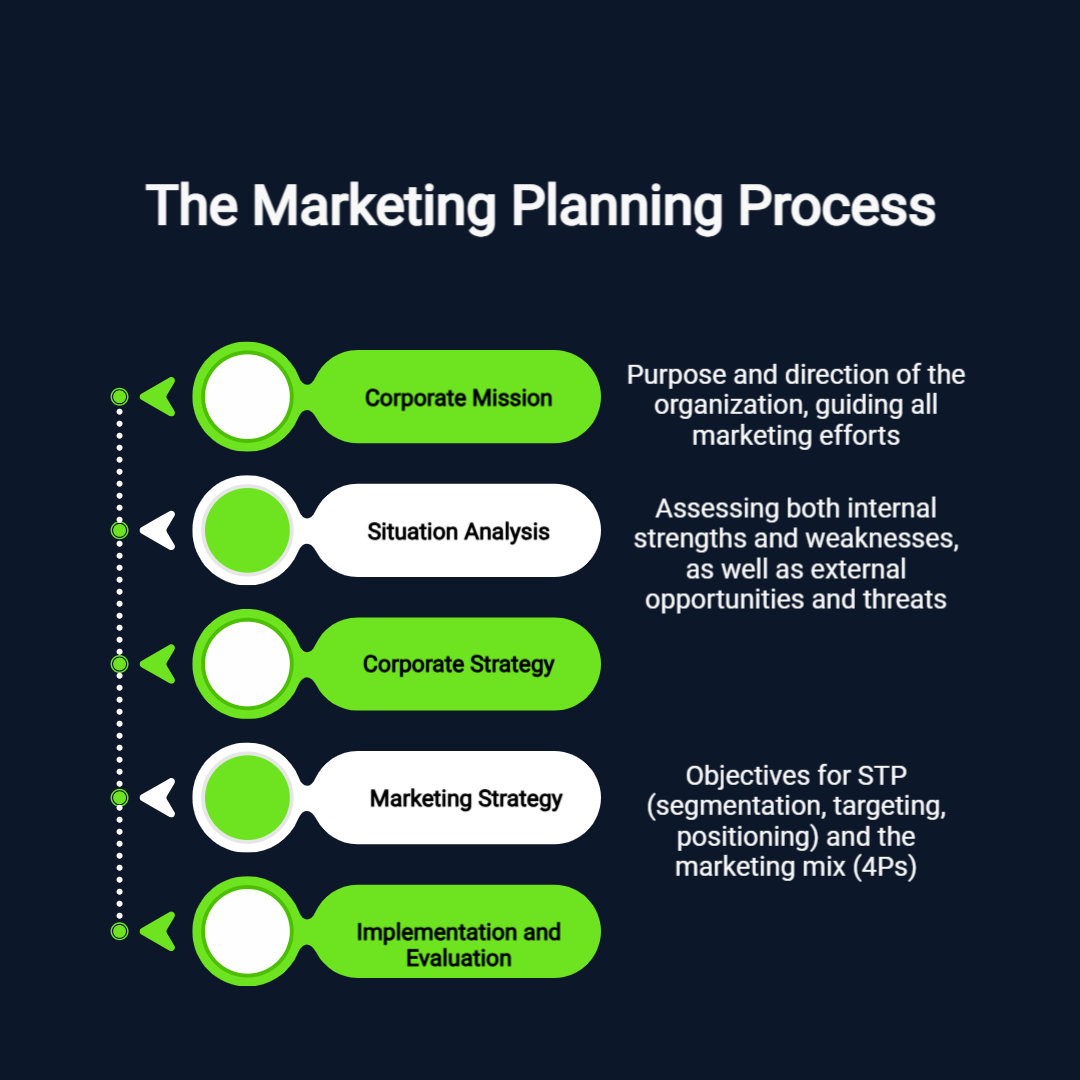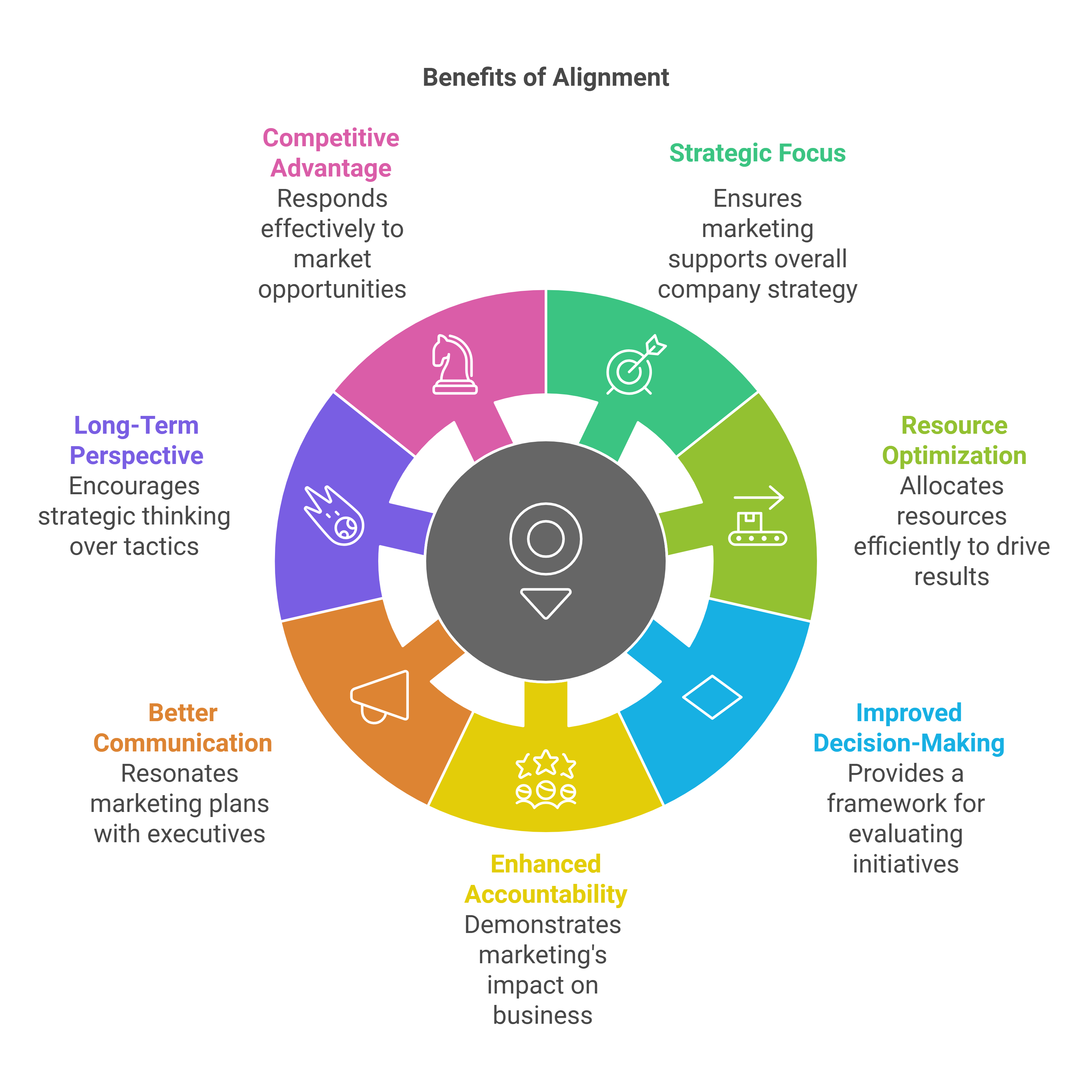Future Horizons: Strategic Planning in Marketing
Marketing Planning
It is important to distinguish between strategic planning and marketing planning.
Strategic Planning vs. Marketing Planning
Strategic planning and marketing planning are closely related but distinct processes that play critical roles in business success. Strategic planning is broader and typically occurs at the organizational level, setting the overall direction for the company. Marketing planning, on the other hand, is a more specific process that focuses on achieving marketing objectives within the framework of the broader strategic plan.
In essence, marketing planning is a subset of strategic planning, ensuring that marketing efforts align with and support the organization’s overall strategy.

Strategic Planning
Strategic planning is a broad, organization-wide process that defines the company’s overall mission, vision, values, direction, goals, and priorities. It serves as the foundation for all other plans within the organization, including marketing planning.
Key Characteristics:
- Scope: Focused on the entire organization, encompassing all departments, such as operations, human resources, finance, product development, and marketing.
- Purpose: To set long-term objectives.
- Outcome: A roadmap that outlines how the organization will achieve its overarching goals.
Example
Strategic Planning
A hotel chain like Hilton might develop a strategic plan with goals such as expanding into new markets, achieving sustainability targets (e.g., reducing carbon emissions by 50% by 2030), and increasing profitability by 20% over five years. This broad strategy informs specific departmental plans, including marketing.
Marketing Planning
Marketing planning is a more focused process that operates within the framework of the broader strategic plan. It outlines specific actions to achieve marketing objectives, ensuring alignment with the company’s overall strategy.
Key Characteristics:
- Scope: Focused on marketing activities such as customer acquisition, branding, pricing, promotion, distribution channels, and market segmentation.
- Purpose: To translate organizational goals into actionable marketing initiatives.
- Outcome: A detailed plan for executing campaigns, allocating budgets, and measuring success.
Example
Marketing Planning
Within Hilton’s strategic plan to expand into new markets, its marketing plan might include launching targeted campaigns in Asia-Pacific markets to attract local travelers. This could involve digital advertising on regional platforms, partnerships with influencers, and promotions tailored to cultural preferences.
Key Differences
| Element | Strategic Planning | Marketing Planning |
|---|---|---|
| Focus | Organization-wide goals | Specific marketing objectives |
| Timeframe | Long-term (3–5 years or more) | Short-to-medium term (1–3 years) |
| Scope | Broad (operations, HR, finance, etc.) | Narrower (branding, promotion, and customer acquisition) |
| Purpose | Sets overall direction for the company | Guides marketing efforts to support strategic goals |
| Example Objective | Expand into new geographic markets | Increase brand awareness in a specific region by 30% |
Essential Components of a Marketing Plan
Marketing plans can take many forms, as there is no universally agreed-upon format or set of components. Different organizations and marketing experts propose varying structures, with some plans including as few as five or six elements, while others may feature twelve or more. The structure of a marketing plan is often shaped by the organization’s specific goals, industry, and context.
Despite this variability, most marketing plans share common elements, such as an executive summary, situation analysis, target audience identification, and financial planning. However, the emphasis and depth of these components can differ significantly depending on organizational priorities, industry standards, and specific objectives.
A successful marketing plan integrates several essential components that work together to form a comprehensive strategy for achieving marketing objectives. Below are the key elements typically included in a marketing plan:
- Executive Summary:
- Provides a high-level overview of the marketing plan, summarizing its purpose, key objectives, and expected outcomes
- This section is designed to give stakeholders a concise understanding of the plan’s overall direction
- Situation Analysis:
- Evaluates the current internal and external environment affecting the organization
- Market Analysis:
- Focuses on identifying target audiences through segmentation based on demographics, psychographics, behavior, and geography
- Includes insights into customer needs and competitor positioning
- Marketing Strategy:
- Communicates the goals and objectives for the marketing efforts
- Outlines how the organization will achieve its goals through its positioning strategy, value proposition, unique selling proposition (USP), and marketing mix (4Ps)
- Financial Analysis:
- Details the budget allocated for marketing activities and projects expected returns on investment (ROI)
- Includes cost breakdowns for campaigns and initiatives as well as financial performance metrics
- Implementation and Evaluation:
- Specifies how the plan will be executed, including timelines, roles, and responsibilities
- Includes mechanisms for monitoring progress and adjusting strategies based on key performance indicators (KPIs)
Key Elements That Shape Market Planning
Marketing planning is guided by the overall strategic plan of the organization and is shaped by key elements, including:
- Vision, mission, and values
- Situation analysis and environmental scan
- Corporate Strategy
- Marketing strategy
Vision, Mission, and Values[1]
An organization’s vision, mission, and values provide direction, purpose, and the principles that guide decision-making and behaviour across the organization.
Vision Statement
A vision statement articulates the long-term aspirations of an organization — what it hopes to achieve or become in the future. It is broad, inspirational, and forward-looking, serving as a guiding star for stakeholders.
Summary:
- Purpose: The vision statement inspires employees, stakeholders, and customers by providing a clear picture of the desired future.
- Key Characteristics: Aspirational, memorable, concise, and motivating.
Mission Statement
A mission statement describes what the organization does in the present to achieve its vision. It is more specific than the vision statement and focuses on actions that differentiate the organization from others in its industry.
Summary:
- Purpose: Defines the organization’s purpose and outlines how it creates value for stakeholders.
- Key Characteristics: Action-oriented, specific, concise, and focused on current objectives.
Vaues Statement
A values statement outlines the core principles and ethics that guide an organization’s behavior. It reflects what the organization stands for and how it expects employees to act internally and externally.
Summary:
- Purpose: Shapes organizational culture by influencing decision-making and stakeholder relationships.
- Key Characteristics: Ethical, actionable, aligned with organizational goals.
“3 Things that Make a MEANINGFUL Vision | Simon Sinek” [4:29 min] by Simon Sinek[2]
If you are using a printed copy, you can scan the QR code with your digital device to go directly to the video: 3 Things that Make a MEANINGFUL Vision | Simon Sinek

Examples
Mission, Vision, and Values
| Organization | Vision | Mission | Values |
|---|---|---|---|
| Tourism Richmond[3] | Richmond is a can’t-miss part of the Metro-Vancouver experience. | Building Richmond’s reputation and making it a desirable place to live, work, and visit. | EPIC:
|
| Travel Oregon[4] | Oregon is a welcoming destination where tourism drives economic prosperity, benefits the natural environment and celebrates rich, diverse cultures. | We inspire travel that uplifts Oregon communities. Collaborating with stakeholders to align as stewards of Oregon, we work to optimize economic opportunity, advance equity and respect the ecosystems, cultures and places that make Oregon…Oregon. |
|
| Wyndham Hotels[5] | To be the world’s largest and most diverse hotel company providing memorable experiences. | Providing exceptional hospitality and value to guests, franchisees, and employees. |
|
| Marriott International[6] | To be the world’s favorite travel company. | Does not have a mission statement. |
|
| Airbnb[7] | Belong anywhere. | To create a world where anyone can belong anywhere. |
|
Situation Analysis and Environmental Scans
Situation analysis and environmental scans assess an organization’s current position by:
- Internally evaluating the organization’s resources, capabilities, and performance
- Externally examining market trends, the competitive landscape, and broader environmental factors

Corporate Strategy
Corporate strategy provides the overall direction and approach for achieving the company’s long-term goals and objectives. It provides the overall framework within which marketing strategy is developed.
Marketing Strategy
Marketing strategy helps execute key elements of corporate strategy related to market positioning, growth, customer relationships, and marketing mix decisions. It determines how the company will attract customers and sell its products/services in the marketplace. Marketing strategy is aligned with and supports the broader corporate objectives.

Aligning Organizational and Marketing Objectives
Objectives are goals that an organization aims to achieve within a defined timeframe. If defined effectively, they serve as concrete targets that guide decision-making and action across the organization.
To be effective, these goals should be specific, measurable, achievable, relevant, and time-bound (also known as SMART objectives). Each element helps ensure that objectives are well-defined, and attainable, making it easier to track progress and achieve desired outcomes.
SMART Goals/Objectives:
- Specific: The objective should clearly define what is to be achieved, who is responsible, and the actions required.
- Measurable: There should be criteria in place to measure progress and success, allowing for tracking of how much or how well the goal has been met.
- Achievable: The goal should be realistic and attainable, considering available resources and constraints.
- Relevant: The objective should align with broader organizational goals and be meaningful to the team or organization.
- Time-bound: A specific timeframe should be set for achieving the objective, creating a sense of urgency.
Example
SMART Objectives
Cozy Retreat Hotel
Organizational Objective: Increase overall occupancy rates by 15% within the next year.
SMART Marketing Objective:
- Specific: Increase direct bookings through the hotel’s website.
- Measurable: Achieve a 25% increase in direct bookings.
- Achievable: This is feasible based on previous booking trends and marketing efforts.
- Relevant: This aligns with the hotel’s goal to reduce reliance on third-party booking sites.
- Time-bound: Achieve this increase by December 31, 2025.
This SMART objective provides a clear target for the hotel’s marketing efforts, ensuring that everyone involved understands what needs to be accomplished and by when. It also allows the hotel to measure progress effectively and make necessary adjustments along the way.

As we learned earlier in this chapter, organizational objectives are high-level goals that reflect the overall direction and priorities of the company. These might include targets for revenue growth, market share, profitability, or expansion into new markets.
Marketing objectives are more specific goals related to marketing activities. These could include increasing brand awareness, generating leads, improving customer retention, or launching new products successfully.
Aligning organizational and marketing objectives is crucial for several reasons:
- Strategic Focus: Alignment ensures that marketing efforts directly support the company’s overall strategy and goals, creating a unified direction.
- Resource Optimization: When objectives are aligned, resources are allocated more efficiently to activities that drive business results.
- Improved Decision-Making: Alignment provides a clear framework for evaluating marketing initiatives based on their contribution to broader business objectives.
- Enhanced Accountability: Marketers can demonstrate their value and impact on the business more effectively when their goals are tied to organizational objectives.
- Better Communication: Alignment helps marketers communicate their plans and results in terms that resonate with executives and other departments.
- Long-Term Perspective: Tying marketing objectives to organizational goals encourages a longer-term strategic perspective rather than short-term tactical thinking.
- Competitive Advantage: A well-aligned organization can respond more cohesively and effectively to market opportunities and threats.

Example
Alignment of Organizational and Marketing Objectives
Sunny Haven Inn with SMART Goals
Organizational Objective: Increase total annual revenue by 20% from $500,000 to $600,000 by December 31, 2025.
Aligned Marketing Objectives:
- Increase direct bookings through the inn’s website from 40% to 55% of total bookings by December 31, 2025.
- Grow social media following on Instagram from 5,000 to 8,000 followers by June 30, 2025.
- Improve the repeat guest rate from 30% to 40% of total bookings by December 31, 2025.
How They Align Their Marketing Efforts:
- Website Improvement:
- Redesign the website by March 31, 2025, to make booking easier and more attractive.
- Implement a pop-up offering a 10% discount for direct bookings by April 30, 2025.
- Social Media Engagement:
- Post at least 5 high-quality photos or videos per week showcasing the inn and local attractions.
- Run a quarterly photo contest where guests can win a free night’s stay, starting January 1, 2025.
- Email Campaigns:
- Send monthly newsletters to past guests featuring seasonal promotions and local events.
- Implement an automated email series for post-stay follow-ups by May 31, 2025.
- Loyalty Program:
- Launch a “Stay 5, Get 1 Free” program by February 28, 2025.
- Offer a 15% discount to returning guests for weekday bookings, effective March 1, 2025.
- Community Involvement:
- Partner with at least 3 local businesses to create package deals by July 31, 2025.
- Host a quarterly community event at the inn, starting from Q2 2025.

Implementation and Evaluation

Implementation and evaluation (also known as control) represent the phases involved in executing a marketing plan.
Implementation involves putting the marketing strategy into action through specific procedures and activities. This includes developing detailed action plans, assigning responsibilities to team members, allocating resources, and setting timelines for various tasks.
Evaluation focuses on monitoring progress and measuring success. It involves establishing key performance indicators (KPIs) to track the effectiveness of marketing efforts. KPIs are quantifiable metrics used to measure and demonstrate how effectively objectives are being achieved. KPIs might include metrics such as customer acquisition cost, conversion rates, or return on marketing investment. Regular monitoring and analysis of these metrics allow marketers to assess the performance of their campaigns and make data-driven adjustments as needed.
Methods for monitoring progress include regular reporting, performance reviews, and customer feedback analysis. By implementing a system of implementation and evaluation, organizations can ensure that their marketing strategies are executed effectively and can quickly adapt to changing market conditions or underperforming initiatives.

Examples
Key Performance Indicators
| KPI Type | Definition | Examples |
|---|---|---|
| Financial | Measures an organization’s financial health, profitability, and growth. |
|
| Customer | Evaluates customer satisfaction, retention, and the cost to acquire customers. |
|
| Process | Tracks operational efficiency, quality control, and productivity. |
|
| Employee | Monitors employee engagement, satisfaction, and workforce performance. |
|
Media Attributions
- Figure 1: “Business Planning Concepts” by geralt (2020), via Pixabay, is used under the Pixabay content license.
- Figure 2: “Environmental scan” [created using DALL-E with prompt: “please produce a simple but colorful image representing an environmental scan/ please make it feel adventurous”] by the author is under a CC BY-NC-SA 4.0 license.
- Figure 3: “The marketing planning process” [created using Infography] by the author is under a CC BY-NC-SA 4.0 license.
- Figure 4: “Climbing” by Marcus Hansson (2014), via Flickr, is used under a CC BY 2.0 license.
- Figure 5: “Benefits of aligning organizational and marketing objectives” [created using Napkin.ai] by the author is under a CC BY-NC-SA 4.0 license.
- Figure 6: “Facade of the Hochelaga Inn, Kingston, Canada” by Esteban Arango (2022), via Pexels, is used under the Pexels license.
- Figure 7: “Graveyard Lemonade Stand” by Nina Frazier (2008), via Flickr, is used under a CC BY-SA 2.0 license.
- Figure 8: “Key performance indicators” [created using DALL-E with prompt: “please produce a colorful simple image of key performance indicators”] by the author is under a CC BY-NC-SA 4.0 license.
- Cady, S. H., Wheeler, J. V., DeWolf, J., & Brodke, M. (2011). Mission, vision, and values: What do they say? Organization Development Journal, 29(1), 63–78. https://www.researchgate.net/publication/259265396_Mission_vision_and_values_What_do_they_say ↵
- Simon Sinek. (2020, December 30). 3 things that make a meaningful vision | Simon Sinek [Video]. YouTube. https://youtu.be/zpzZumZCdWA?si=XuHM3PasCrnnk6_p ↵
- Tourism Richmond. (n.d.). Corporate information. Retrieved January 6, 2025, from https://www.visitrichmondbc.com/about-us/corporate-information/ ↵
- Travel Oregon. (n.d.). Vision, mission & values. Retrieved January 6, 2025, from https://industry.traveloregon.com/about/vision-mission-values/ ↵
- Wyndham Hotels & Resorts. (n.d.). Mission, values and vision. Retrieved January 6, 2025, from https://development.wyndhamhotels.com/mission-values-and-vision/ ↵
- Marriott International. (2012). Principles of responsible business. https://www.marriott.com/marriottassets/Multimedia/PDF/CorporateResponsibility/Principles_Responsible_Business.pdf ↵
- Airbnb. (n.d.). Life at Airbnb. Retrieved January 6, 2025, from https://careers.airbnb.com/life-at-airbnb/ ↵
A comprehensive process that defines an organization’s long-term goals and outlines the steps to achieve them, aligning resources and efforts across all levels.
The process of creating a detailed roadmap for an organization's marketing activities, typically including situation analysis, goal setting, strategy formulation, and tactics development.
Specific, measurable goals that a company aims to achieve through its marketing efforts, typically aligned with broader organizational goals.
A comprehensive examination of an organization's internal and external environment to inform strategic decision-making.
The overall scope and direction of an organization and the way in which its various business operations work together to achieve particular goals.
A subset of strategic planning focused on identifying and executing initiatives to attract and retain customers, support organizational goals, and establish a competitive edge
A framework for setting goals that are Specific, Measurable, Achievable, Relevant, and Time-bound.
A condition or circumstance that puts a company in a favorable or superior business position relative to its competitors.
Quantifiable metrics used to evaluate the success of an organization, employee, or project in meeting objectives for performance.

